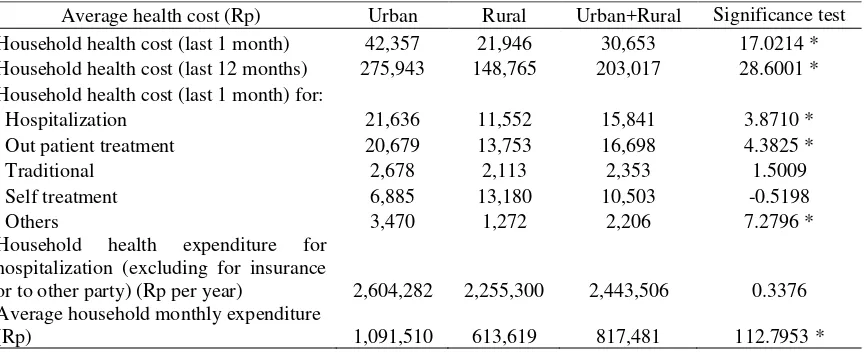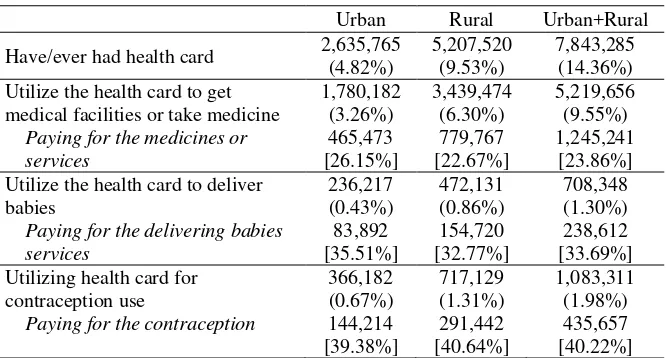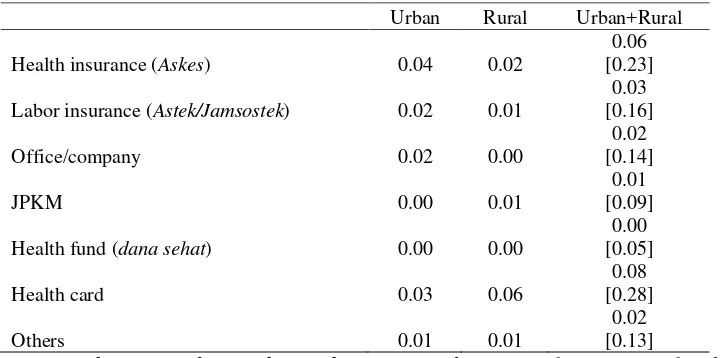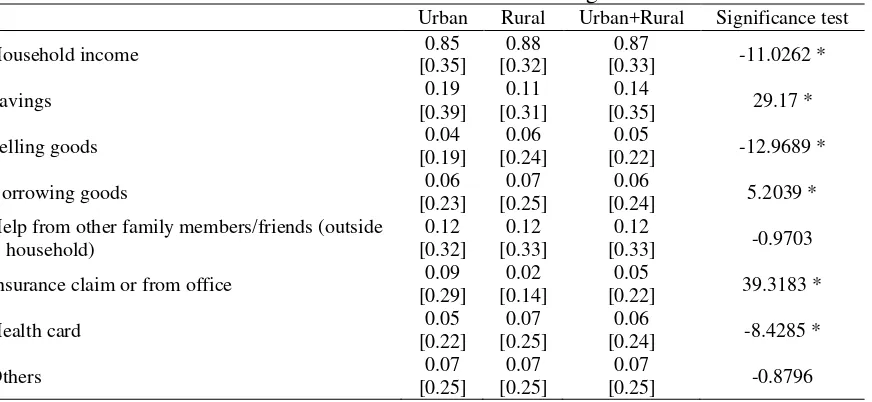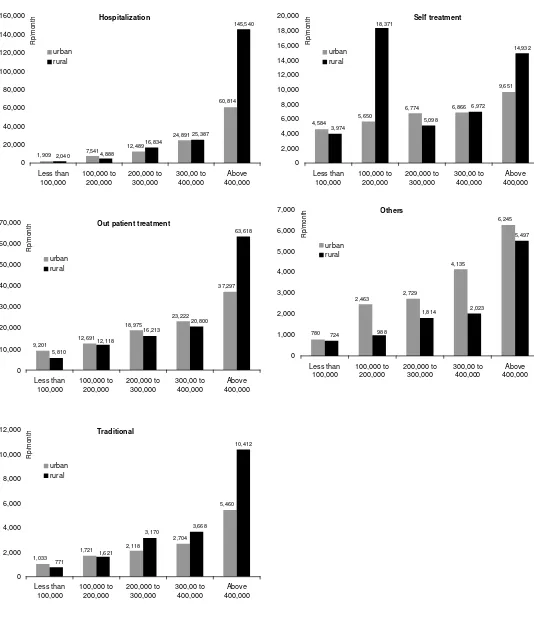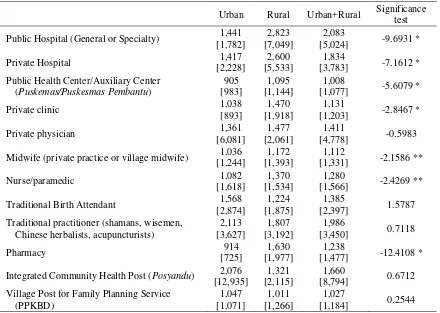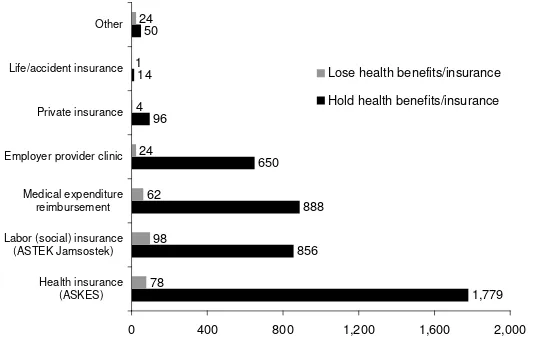HEALTH COST IN INDONESIA:
EVIDENCES FROM IFLS AND SUSENAS DATA
Muhammad Ryan Sanjaya1 Charoen Pokphand Indonesia
ABSTRAKSI
Artikel ini menggunakan pendekatan statistik deskriptif dari data Susenas dan IFLS untuk mengetahui biaya dan pola pengeluaran untuk kesehatan masyarakat Indonesia. Dari data Susenas 2004 diketahui bahwa mayoritas rumah tangga menggunakan pendapatan mereka sendiri untuk membiayai pengeluaran kesehatan, dan hanya sedikit yang menggunakan asuransi kesehatan maupun kartu sehat. Secara statistik terbukti bahwa pola pengeluaran penduduk kota berbeda dan lebih tinggi dibandingkan dengan masyarakat pedesaan. Juga ditemukan bahwa pengeluaran untuk kesehatan berkorelasi positif dengan pengeluaran rumah tangga. Sementara dari data Indonesia Family Life Survey(IFLS) tahun 2000 ditemukan bahwa pangsa
pengeluaran untuk kesehatan lebih rendah dibandingkan data yang didapat dari Susenas. Ongkos transportasi ke fasilitas medik menambah pengeluaran untuk kesehatan terutama bagi penduduk desa karena keterbatasan akses terhadap fasilitas-fasilitas tersebut. Meskipun penelitian ini memakai dua basis data namun hasil yang didapat tidak dapat diperbandingkan secara langsung mengingat keduanya memiliki metode, karakteristik, dan periode waktu yang berbeda.
Kata kunci: health economics, economic development, Susenas, Indonesia Family
Life Survey
Introduction
The popularity of health economics within economic theory is still lagged behind those of more well-known subjects such as monetary issue and international trade. The cause of this unpopularity can be attributed to limited data availability and the inexistence of robust building blocks that uniquely differentiate it with other branches of economics. For this reason, there are quite a small number of researches concerning health economics in Indonesia. This article is an attempt to fill the gap.
1 The author would like to thanks to Dharendra Wardhana for it is valuable support on the data and to
In Indonesia, formulation of health policy must considering the capacity of households (or individuals) in obtaining health facility. The capacity includes cost to obtain medical benefit/assistance, which induce to the willingness to pay for those benefits, and underlying factors of household/individual behavior toward health benefits. One of an excellent study was from Pradhan et al. (2004) that utilize Susenas data to measure the effectiveness of health card program in Indonesia during economic crisis. By knowing the exact nature and structure of health awareness of Indonesian, a better health-related policy can be proposed.
This article will focused on the statistical aspect rather than on causal/regression method of health issue in Indonesia. Designed as a continuing study, this article is limited to certain aspect of health economics for the case of Indonesia. Future studies will be performed by introducing more advanced methodologies and might be inherent with current article. The study will employ and analyze micro-level data taken from latest raw datasets of National Socio-Economic Survey (Susenas) and the Indonesia Family Life Survey (IFLS).
Health Issue in Indonesia
sensitive to change in public spending on health, it was the non-poor that receive some of the benefit from the program. In the end, it was the non-poor who captured most of the benefits of the overall program.
Another study was from Thomas & Frankenberg (2005) that deeply use the IFLS data to analyze the longitudinal response of household, concerning not only health issue but also to poverty, resources, and well-being. While they have already conduct deep descriptive statistical method in analyzing each health-related issue within IFLS (nutrition, psycho-social health, and general health), an indirect comparison between results from IFLS and Susenas are not yet been explored.
Research Methodology
In this article we purely use statistics to measure health expenditure in Indonesia. To calculate household expenditure in Susenas data we count the mean of expenditure data for each household weighted by the already built-in (made by BPS) weight measure, so that the number can be justified for the whole Indonesia. While for IFLS, we do not perform such weighted measure since there was no built-in weight within IFLS. Thus, the consequence is that the result from IFLS can be over- or undervalued. Total expenditure will be measured as a sum of food and non-food expenditure.
Following is the standard conversion basis used by BPS within Susenas employed to the data:
Value of 1 year = 12 x value of 1 month Value of 1 month = (30/4) x value of 1 week
number to simplify and to create more statistical sense of the data. The conversions were used for questions that only had two mutually exclusive answers—“1” for “yes” answer and “2” for “no” answer—by changing the “2” into “0”. Thus the average
value from the newly converted data can be used as an approximate of proportion of sample answering “yes” or “no”.
Significance test were also applied for some part of this article that used to know whether the pattern is statistically similar or different between urban and rural areas. Since the data are unpaired (urban and rural sample size is not equal) and coming from different population characteristics suggest that the appropriate t-test is for two samples with unequal variance.
Within this research, we used raw data to analyze the statistical aspect of health expenditure. Stata/SE 8.0 was used to conduct statistical measures of the raw data. It is important to acknowledge the importance of utilizing such raw datasets for they contain large amount of data which provide broad room for data analyses and manipulations.
The Data
Household and individual type data were employed to capture the micro-level pattern of health expenditure in Indonesia. There are currently two available data resources which provide a relatively complete measure of health issues, especially on health expenditure, namely Indonesia’s National Socio-Economic Survey (Susenas) and Indonesia Family Life Survey (IFLS).
panel study purpose. The Susenas data is divided into core and module questionnaires. Core questionnaire consists of nine areas of developments that collected in yearly basis. While on the other hand, there are currently three kinds of module questionnaires (Surbakti, 1995):
1. Income and expenditure
2. Welfare, socio-culture, criminality, and tourism
3. Health, nutrition, education cost, and home environment
Each of these modules is repeated every three years. The latest raw data available for public audiences is Susenas 2004 which we will use thoroughly within this article.
The other dataset is Indonesia’s Family Life Survey, also known as Survey
Aspek Kehidupan Rumah Tangga Indonesia (Sakerti). The IFLS is a longitudinal survey for Indonesian household initially conducted by RAND, Lembaga Demografi of Universitas Indonesia, and UCLA in 1993/4. The survey covered extensive information including lives of the respondents, their households, their families, and the community they live. Representing about 83 percent of Indonesia population, the survey conducted interview of more than 30,000 individuals. The IFLS were performed in “waves”: the first (IFLS1) wave was conducted in 1993/4 period, followed by IFLS2 (1997/8), specially-purposed IFLS2+ (late 1998), IFLS3 (2000), and IFLS4 scheduled to be launched next 2007. RAND and UGM collaborate in the latest survey (IFLS3). Since these waves were completed by interviewing the same
dimension. Much of the issues within IFLS were deeply explored if compared to Susenas.
In this research, we were using Susenas 2004 and IFLS3 (2000) as our datasets because these two datasets are the most updated data available for public audiences. The impact of using these datasets is that they can not be compared directly due to different time period implying different socio-economic circumstances. Susenas 2004 surveyed more than one million individuals and more than 250 thousand households for the core questionnaire. While for the module, the survey interviewed more than 66 thousand households. On the other hand, there were more than 70 thousand households interviewed from 13 provinces covering about 83 percent of total population in IFLS3 that answered the health-cost-related questions. Expenditures in IFLS are expressed in 1994 base price and adjusted by regional price deflators to the price level of Jakarta (Cogneau & Grimm, 2004).
The advantages of using both IFLS and Susenas data is that we can analyze the health cost issue from two different point of view, though they can not be compared indirectly. It is reasonable not only because the methodologies are almost completely different, but also due to the fact that these two datasets are bearing different stress. Susenas is mainly concern on the general aspect of household life, but IFLS tend to be more detailed on touching the household issue and even reached the community level.
Results
Results from Susenas Data
Susenas 2004 was used to analyze and measure the health-related cost of Indonesian households and individuals. The data is the latest one available in Stata format. In summary, household expenditure for health is about Rp30,000/month on average or 3.75 percent of total household monthly expenditure, with those living in cities spent more than those in rural areas. While the Susenas questionnaire also asked for the annual average health expenditure which resulted in Rp200,000/year on average. The number is not equal to 12 month multiplied by the monthly average (12 month x Rp30,000/month = Rp360,000/year), because for the monthly health expenditure the respondent is actually asked for last month health expenditure, thus we can not simply multiply it by 12 month.
Table 1. Results from Susenas 2004 Data
Average health cost (Rp) Urban Rural Urban+Rural Significance test Household health cost (last 1 month) 42,357 21,946 30,653 17.0214 * Household health cost (last 12 months) 275,943 148,765 203,017 28.6001 * Household health cost (last 1 month) for:
Hospitalization 21,636 11,552 15,841 3.8710 *
Out patient treatment 20,679 13,753 16,698 4.3825 *
Traditional 2,678 2,113 2,353 1.5009
Self treatment 6,885 13,180 10,503 -0.5198
Others 3,470 1,272 2,206 7.2796 *
Household health expenditure for hospitalization (excluding for insurance
or to other party) (Rp per year) 2,604,282 2,255,300 2,443,506 0.3376 Average household monthly expenditure
(Rp) 1,091,510 613,619 817,481 112.7953 *
Notes: Significance test measure the independent t-test for unequal variance between urban and rural household health and total expenditure. Value displayed with significant t-value (*) indicates that the mean between urban and rural is significantly different at 1% level.
Source: calculated from Susenas 2004 data
living in rural areas. It is still unknown whether the health cost, access to medical facilities, or other factors that generate such pattern. A mixed result, however, occurred for hospitalization expenditure where population in urban areas is significantly paid out more money for in-patient treatment than those in rural for the
last one month but not in a year as a whole.
Table 2. Household Health Card Ownership and Utilization Urban Rural Urban+Rural Have/ever had health card 2,635,765
(4.82%)
5,207,520 (9.53%)
7,843,285 (14.36%) Utilize the health card to get
medical facilities or take medicine
1,780,182
Paying for the medicines or
services [26.15%] 465,473
779,767 [22.67%]
1,245,241 [23.86%] Utilize the health card to deliver
babies
Paying for the delivering babies
services [35.51%] 83,892
154,720 [32.77%]
238,612 [33.69%] Utilizing health card for
contraception use
Paying for the contraception 144,214 [39.38%] facilities. Significance test measure the independent t-test for unequal variance between urban and rural household health card utilization. Value displayed with significant t-value (*) indicates that the mean between urban and rural is significantly different at 1% level.
Source: calculated from Susenas 2004 data
Most of the respondent (household) questioned said that they never had health card, with the propensity of having health card is larger for those living in rural areas than those living in cities. This confirmed by the fact that most of the poor lives in rural areas rather than in cities (see Figure 1 below). Most of the respondent used the health card to go to medical facilities or to get medicines rather than for delivering babies and/or for contraception use. It is quite interesting that urban people tend to
pay more than their counterpart in rural areas for health facilities even though they
Figure 1. Percentage of People Living Below Poverty Line
0 5 10 15 20 25 30
1996 1998 1999 2000 2001 2002 2003 2004 2005 March
2006
%
Urban
Rural
Source: BPS
The need for health insurance or provision in Indonesia is emerging for most of the respondent claimed that they do not have any access to or supplied with health insurance, issued whether by public (government) or private institutions (current place of work). There only six percent from total Indonesia population that currently hold health insurance (Askes) and almost none that already have health fund (dana sehat). Similar to above result, urban citizen seems to have broader ownership of health insurance/financing rather than rural villagers, with exceptions in JKPM and health card ownership.
Table 3. Health Financing/Insurance Ownership
Urban Rural Urban+Rural Health insurance (Askes) 0.04 0.02
0.06 [0.23] Labor insurance (Astek/Jamsostek) 0.02 0.01
0.03 [0.16]
Office/company 0.02 0.00
0.02 [0.14]
JPKM 0.00 0.01
0.01 [0.09] Health fund (dana sehat) 0.00 0.00
0.00 [0.05]
Health card 0.03 0.06
0.08 [0.28]
Others 0.01 0.01
0.02 [0.13]
Notes: Value is “1” if respondent said “yes”, “0” if “no”. Number in square brackets [ ]
The module questionnaire of Susenas 2004 is fortunately embraces the same scope with this research, which is for health, education, and home environment issues. Somewhat contrary to those of above core results, households in module data were posing higher monthly health expenditure at about Rp47,000 for national average. Cost for hospitalization for the last one year is about Rp2.4 million on average.
Most of the respondent said that they financed health expenditure by their own income, and only small fraction financed through other means such by using their saving deposit or by utilizing health card. This might be explained by the low ownership of (ever have or currently hold) health card that just owned by 14 percent of total Indonesian household. Pradhan et al. (2004) also confirmed that after the 1997/1998 crisis there was a sharp decrease in the utilization of modern health care which was largely due to declining utilization of public sector providers. The second highest source of health financing is from personal savings followed by financial help from other family members or friends.
Table 4. Source of Health Financing
Urban Rural Urban+Rural Significance test
Household income 0.85
[0.35]
Selling goods 0.04
[0.19]
0.06 [0.24]
0.05
[0.22] -12.9689 *
Borrowing goods 0.06
[0.23]
0.07 [0.25]
0.06
[0.24] 5.2039 * Help from other family members/friends (outside
household) Insurance claim or from office 0.09
[0.29]
standard deviation from the mean. Significance test measure the independent t-test for unequal variance between urban and rural household source of health financing. Value displayed with significant t-value (*) indicates that the mean between urban and rural is significantly different at 1% level.
It can be inferred from above table that there were significant differences between rural and urban health financing pattern for all source financing with exceptions for help from the other family members/friends and the other source of financing. Another clear picture is the use of insurance claim for health by urban citizen that much exceeds rural habitants. This finding obviously proved that health insurance penetration is still hovering in cities and not yet touch rural villages.
Figure 2 below exhibit number of household after grouped into ten different categories based on average monthly expenditure and origin (urban and rural). It is necessary to understand the health cost pattern not only based on spatial aspect but also based on their expenditure pattern.
Figure 2. Number of Household Based on Monthly Expenditure and Origin
Urban Rural
Less than 100,000, 831,539
100,000 to 200,000, 7,859,385
200,000 to 300,000, 6,622,740 300,00 to 400,000,
3,501,156
Above 400,000,
4,507,067 Less than 100,000,
4,821,104
100,000 to 200,000, 18,743,557 Above 400,000,
909,746 300,00 to 400,000,
1,354,304
200,000 to 300,000, 5,705,378
Source: calculated from Susenas 2004 data
While the share is relatively equal among monthly expenditure range for urban area, most of the respondents (>50 percent) in rural area spent between Rp100,000-Rp200,000 per month. After grouping the respondent in term of per capita expenditure, it was found that total health cost for Indonesian household is positively
Figure 3. Health Expenditure by Per Capita Expenditure Group and Origin
It is intriguing that in all but “Others” health expenditure, rural villagers
Table 5. Health Expenditure by Per Capita Expenditure Group and Origin (Rp/month)
Notes: number in square brackets [ ] indicate standard deviation from the mean
Source: calculated from Susenas 2004 data
Less than 100,000 100,000 to 200,000 200,000 to 300,000 300,000 to 400,000 Above 400,000
Urban Rural Urban Rural Urban Rural Urban Rural Urban Rural Out patient treatment 9,201
[37,625] Self treatment 4,584
Results from IFLS Data
Expenditure of Indonesian household based on IFLS data is much higher than those measured within Susenas. In 2000, average household expenditure counted for about Rp1.1 million/month, or 34 percent higher than in Susenas 2004 that counted for just about Rp817,000/month. Of course these numbers are not comparable due to different methodologies of surveys conducted and clearly on different time basis.
Average health expenditure within IFLS3 data showed higher figure than those of Susenas 2004. Average annual health expenditure was around 20 percent of total expenditure, or just about 1 percent lower than the Susenas 2004 (21 percent of total expenditure). Besides common health expenditure, IFLS also measure the value of health facilities/medicine obtained by household that was self-produced or received from another source. The value is about 20 percent of total health expenditure.
Table 6. Household Medical Cost During The Past One Year (Rp/year) Urban Rural Urban+Rural Total medical cost expenditure 369,737
[3,153,708]
161,480 [586,449]
261,208 [2,225,377] Self produced or received from another
source
83,869 [993,084]
23,287 [476,227]
52,318 [769,136]
Notes: number in square brackets [ ] indicates standard deviation from the mean
Source: calculated from IFLS3 data
Table 7. Transportation Cost to Health Facilities (Rp per visit)
Urban Rural Urban+Rural Significance test Public Hospital (General or Specialty) 1,441
[1,782]
2,823 [7,049]
2,083
[5,024] -9.6931 *
Private Hospital 1,417
[2,228]
2,600 [5,533]
1,834
[3,783] -7.1612 * Public Health Center/Auxiliary Center
(Puskemas/Puskesmas Pembantu)
905
Private physician 1,361
[6,081]
1,477 [2,061]
1,411
[4,778] -0.5983 Midwife (private practice or village midwife) 1,036
[1,244] Traditional Birth Attendant 1,568
[2,874]
1,224 [1,875]
1,385
[2,397] 1.5787 Traditional practitioner (shamans, wisemen,
Chinese herbalists, acupuncturists)
2,113 Integrated Community Health Post (Posyandu) 2,076
[12,935]
1,321 [2,115]
1,660
[8,794] 0.6712 Village Post for Family Planning Service
(PPKBD)
Notes:number in square brackets [ ] indicates standard deviation from the mean. Including only for
respondent knows the location of health facilities. Significance test measure the independent t-test for unequal variance between urban and rural household transportation cost to medical facilities. Value displayed with significant t-value (* or **) indicates that the mean between urban and rural is significantly different at 1% and 5% significance level respectively.
Source: calculated from IFLS3 data
Significance test showed a mixed result with the most noticeable was for transportation cost to pharmacy and public hospital where urban and rural cost was very different (as shown by highly significant t-statistics). On the other hand, though transportation access to traditional physician, birth attendant, Posyandu, or PPKBD were somewhat higher in urban rather in rural, the statistical test suggest that there were no differences in the cost procured. This result suggests that urban citizen were having very much broader access to any kind of health facilities than rural habitants.
number of respondent saying that they were losing health benefits/insurance. The number, however, is negligible compared to those owning the benefits/insurance facilities.
Figure 4. Number of Respondent Having Health Benefits/Insurance Facilities
1,779 856
888 650 96
14 50
78 98 62 24 4 1 24
0 400 800 1,200 1,600 2,000
Health insurance (ASKES) Labor (social) insurance
(ASTEK Jamsostek) Medical expenditure
reimbursement Employer provider clinic
Private insurance Life/accident insurance Other
Lose health benefits/insurance
Hold health benefits/insurance
Source: calculated from IFLS3 data
In IFLS, most of the data concerning health issue were purely medical, such as blood pressure, lung capacity and medicine taken. Thus data that directly measured the cost of health is very limited. However, there is considerable space for researchers to explore more on health issue that doesn’t directly correlate with health cost, for example on health-related social safety net (health card) issue or the pattern of contraception use of a community. It is possible to explore such data since IFLS doesn’t just interviewing households but also taking data from community-based institutions, such as Posyandu (Integrated Community Health Post) or PKK (Desa/Kelurahan Women’s Group).
Conclusion and Future Research
expenditure, rather than by utilizing another measures such as health card or health insurance. Health card utilization is relatively low with just 7.8 million households (14.36 percent of total household) claimed to have or ever had it to finance health expenditure. In general, urban health expenditure in Indonesia was significantly different with their counterparts in rural areas, with average health cost is higher in urban rather than in rural. It was found also that health expenditure was moving positively in line with household expenditure. From IFLS3 data, the share of health expenditure to total expenditure is less than those exhibited in Susenas. However, transportation cost to medical facilities adds the health cost, especially to rural villagers since they had limited access to those facilities (especially modern health facilities).
Even though the comparison is not apple-to-apple, but these two data are the latest available resource datasets that employ deep survey on health issues in Indonesia. Thus the results should not be directly compared, rather they should be analyzed separately as both having different and unique characteristics.
References
Cogneau, D. and M. Grimm. 2004. “The Measurement of Income Distribution Dynamics when Demographics are correlated with Income.” Document de travail DIAL/Unité de Recherche CIPRÉ.
Pradhan, M.F., F. Saadah, and R. Sparrow. 2004. “Did the Healthcard Program ensure Access to Medical Care for the Poor during Indonesia’s Economic Crisis? (Revised version September 2004).” Tinbergen Institute Discussion Paper
TI 2003-016/2.
Surbakti, Pajung. 1995. Indonesia’s National Socio-Economic Survey – A continual
data source for analysis on welfare development. Jakarta: Central Bureau of Statistics.
Thomas, D. and E. Frankenberg. 2005. “Household responses to the financial crisis in Indonesia: Logitudinal evidence on poverty, resources and well-being”
California Center for Population Research – On-Line Working Paper Series CCPR-056-05.
